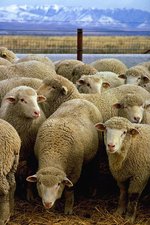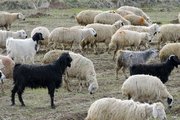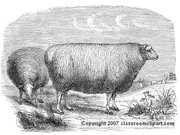Sheep
|
|
| Sheep | ||||||||||||||||
|---|---|---|---|---|---|---|---|---|---|---|---|---|---|---|---|---|
 Romney sheep | ||||||||||||||||
| Scientific classification | ||||||||||||||||
| ||||||||||||||||
| Binomial name | ||||||||||||||||
| Ovis aries Linnaeus, 1758 |
A sheep is any of several woolly ruminant quadrupeds, but most commonly the Domestic Sheep (Ovis aries), which probably descends from the wild moufflon of south-central and south-west Asia. For other types of sheep and their close relatives, see goat antelope. For more information on the raising and breeding of sheep, see "Sheep husbandry".
| Contents |
Classification
There are at least seven species of sheep:
- Argali, Ovis ammon
- Domestic Sheep, Ovis aries
- Bighorn Sheep, Ovis canadensis
- Thinhorn Sheep, Ovis dalli
- Mouflon, Ovis musimon
- Snow Sheep, Ovis nivicola
- Urial, Ovis orientalis
Sheep breeders refer to female sheep as ewes, intact males as rams, castrated males as wethers, yearlings as hoggets, and younger sheep as lambs. Note the adjective applying to sheep: ovine; and the collective terms for sheep: flock and mob.
Many breeds of sheep occur, generally sub-classable as:
- wool breeds, or
- meat breeds, or
- dual use breeds.
Farmers develop wool breeds for superior wool quantity and quality (fineness of fibers), wool staple length and degree of crimp in the fiber. Major wool breeds include Merino, Rambouillet, and Lincoln.
Breeders of meat sheep concentrate on fast growth, multiple births, ease of lambing, and hardiness. Breeds of meat sheep include Suffolk, Hampshire, Dorset, Columbia, and Texel.
Dual-use breeds include the Corriedale. The Finnish Landrace sheep has a reputation for multiple births. Some breeds, called hair sheep, like the Katahdin and Dorper, have little to no wool.
Cultural significance

For centuries, sheep have had associations with many cultures, especially in the Mediterranean area and Wales, where they form the most common type of livestock in pastoralism. Selective breeding of sheep has frequently occurred.
A wide symbology relates to sheep in ancient art, traditions and culture. Judaism uses many sheep references including the Passover lamb. Christianity uses sheep-related images, such as: Christ as the good shepherd, or as the sacrificed Lamb of God (Agnus Dei); the bishop's Pastoral; the lion lying down with the lamb. Greek Easter celebrations traditionally feature a meal of Paschal lamb. Sheep also have considerable importance in Arab culture.
Herding sheep plays an important historico-symbolic part in the Jewish and Christian faiths, since Abraham, Jacob, Moses, and King David all worked as shepherds.
The sheep (or goat) forms one of the animals associated with the 12-year cycle of in the Chinese zodiac, related to the Chinese calendar. Chinese tradition associates each animal is associated with certain personality traits. See: Sheep (Zodiac).
Economic importance
Raising sheep occupied many farmers in ancient economies, given that this animal can give milk (and all its derivative products, such as cheese), wool (and the associated sheepskin used for making footwear and sheepskin rugs) and meat. In the 21st century, sheep retain considerable importance in the economies of areas such as Australia, New Zealand and Uruguay.
In some places, like Sardinia, sheep-breeding has become the principal and characteristic activity.
Even in the 21st century, sheep can provide a return on investment of up to 400% of their cost annually (including reproduction gains). Sheep breeding has played a role in several historic conflicts, such as the Highland clearances, the U.S. range wars, and the English "inclosing of the commons".
Domestication of sheep
Domestic sheep are descended from the moufflon (Ovis orientalis) that is found from the mountains of Turkey to southern Iran. It has been found by DNA analysis to be one of two ancestors of domestic sheep. Although the second ancestor has not been identified, both the urial and argali have been ruled out. The urial (Ovis vignei) is found from northeastern Iran to northwestern India. It has a higher number of chromosomes (58) than domestic sheep (54) which makes it an unlikely ancestor of the latter, but as it interbreeds with the moufflon. The argali sheep (Ovis ammon) of inner Asia (Tibet, Himalayas, Altai, Tien-Shan and Pamir) has 56 chromosomes and the Siberian snow sheep (Ovis nivicola) with 52 chromosomes.
The European moufflon (Ovis musimon) found on Corsica and Sardinia as well as the Cretan and the extinct Cypriot wild sheep are probably descended from early domestic sheep that turned feral. Early domesticated sheep have been found in PPNB Jericho and Zawi Chemi Shanidar. The fleece-bearing sheep is only found since the Bronze Age. Primitive breeds, like the Scottish Soay sheep have to be plucked, not sheared, as the kemps are still longer than the soft fleece, (a process called rooing) or the fleece must be collected from the field after it falls out.
Cuisine
Chefs and diners commonly know sheep meat prepared for food as lamb or mutton (compare the French word for "sheep": mouton). The meat of immature sheep, also termed lamb, generally has a reputation as more tender and appears more often on tables in some western countries. Mutton tastes more flavorful but often seems tougher and fattier than lamb. Lamb commonly features in Mediterranean, Middle Eastern cuisine and South Asian cuisine.
Ethology
Sheep tend to follow the lead of others; hence, one can refer to people as "sheep" when they follow a group of other people. This can occur because such people trust the group, or it can happen because people do not think for themselves. Such passive behaviour can be advantageous in that it offers greater protection from predators, and, if the flock finds a food source, can help ensure that all animals are fed. It can be disadvantageous if the group should make a mistake, such as following the wrong path to a food source.
Sheep follow each other so reliably that special names apply to the different roles sheep play in a flock. One calls a sheep that roams furthest away from the others an outlier (the term also occurs in statistics). This sheep undertakes to go out further away from the safety of the flock to graze, while taking a chance that a predator, such as a wolf, will attack it first because of its isolation. Another sheep, the bellwether, which never goes first but always follows an outlier, signals to the others that they may follow in safety. When it moves, the others will also move. The tendency to act as outliers or as bellwethers, or to stick in the middle of the flock, seems to stay with sheep throughout their whole life. Genes may make them repeat this role behaviour.
Sheep, contrary to popular opinion, have a relatively high level of intelligence. According to a spokesperson of the British National Sheep Association, "Sheep are quite intelligent creatures and have more brainpower than people are willing to give them credit for." [1] (http://news.bbc.co.uk/1/hi/uk/3938591.stm) For example, in Yorkshire sheep found a way to get over cattle grids by rolling on their backs.
Sheep can become hefted by this kind of herd behaviour so that they do not roam far. Since the outbreak of foot and mouth disease in the UK, new flocks have had to be trained to new areas[2] (http://news.bbc.co.uk/1/hi/england/1634526.stm).
Clipart and Animal Pictures
- Clipart (https://classroomclipart.com/image/category/clipart.htm)
- Animal Clipart (https://classroomclipart.com/image/category/animal-clipart.htm)
- Animal Animated Clipart (https://classroomclipart.com/clipart/Animations/Animals.htm)
- Pictures of Animals (https://classroomclipart.com/image/category/animal-photos.htm)
- Amphibian Clip Art, Pictures and Photogaphs (https://classroomclipart.com/image/category/amphibian-clipart.htm)
- Farm Animal Clip Art, Pictures and Photographs (https://classroomclipart.com/image/category/farm-animal-clipart.htm)
- Mammal Clip Art, Pictures and Photographs (https://classroomclipart.com/image/category/mammal-clipart.htm)
- Marine Animal Clip Art, Pictures and Photographs (https://classroomclipart.com/image/category/marine-life-clipart.htm)
- Reptile Clip Art, Pictures and Photographs (https://classroomclipart.com/image/category/reptile-clipart.htm)
- Spider Clip Art, Pictures and Photographs (https://classroomclipart.com/image/category/spider-clipart.htm)




